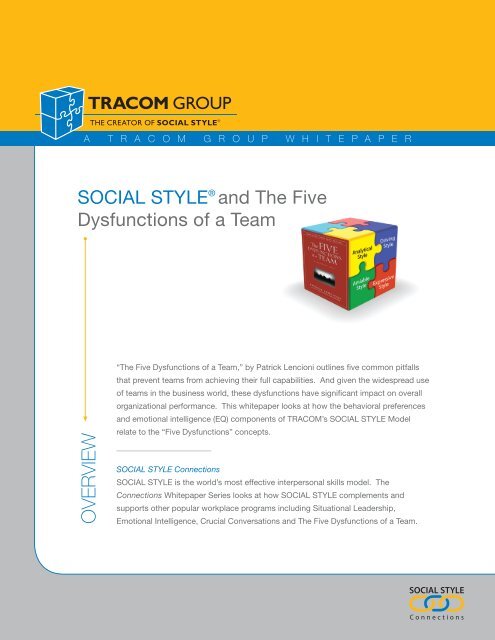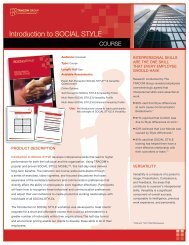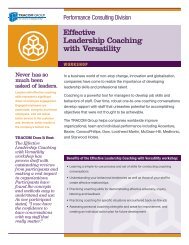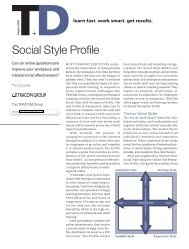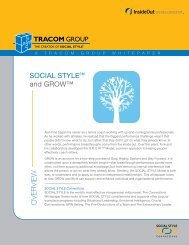Social Style and Five Dysfunctions Whitepaper - The TRACOM Group
Social Style and Five Dysfunctions Whitepaper - The TRACOM Group
Social Style and Five Dysfunctions Whitepaper - The TRACOM Group
Create successful ePaper yourself
Turn your PDF publications into a flip-book with our unique Google optimized e-Paper software.
A T R A C O M G R O U P W H I T E P A P E R<br />
SOCIAL STYLE ® <strong>and</strong> <strong>The</strong> <strong>Five</strong><br />
<strong>Dysfunctions</strong> of a Team<br />
OVERVIEW<br />
“<strong>The</strong> <strong>Five</strong> <strong>Dysfunctions</strong> of a Team,” by Patrick Lencioni outlines five common pitfalls<br />
that prevent teams from achieving their full capabilities. And given the widespread use<br />
of teams in the business world, these dysfunctions have significant impact on overall<br />
organizational performance. This whitepaper looks at how the behavioral preferences<br />
<strong>and</strong> emotional intelligence (EQ) components of <strong>TRACOM</strong>’s SOCIAL STYLE Model<br />
relate to the “<strong>Five</strong> <strong>Dysfunctions</strong>” concepts.<br />
SOCIAL STYLE Connections<br />
SOCIAL STYLE is the world’s most effective interpersonal skills model. <strong>The</strong><br />
Connections <strong>Whitepaper</strong> Series looks at how SOCIAL STYLE complements <strong>and</strong><br />
supports other popular workplace programs including Situational Leadership,<br />
Emotional Intelligence, Crucial Conversations <strong>and</strong> <strong>The</strong> <strong>Five</strong> <strong>Dysfunctions</strong> of a Team.<br />
SOCIAL STYLE<br />
C onnections
www.socialstyle.com<br />
SOCIAL STYLE ® <strong>and</strong> <strong>The</strong> <strong>Five</strong> <strong>Dysfunctions</strong> of a Team<br />
Introduction<br />
SOCIAL STYLE<br />
C onnections<br />
Much of the work performed in organizations today is done by teams. It’s hard to imagine not<br />
contributing to at least one team on any given day. Teams are critical to every organization’s<br />
success; they determine <strong>and</strong> set strategies, generate ideas for new products, <strong>and</strong> solve<br />
problems. Given their importance, why do so many people complain about their teams? If you<br />
ask Patrick Lencioni, it is because most teams are dysfunctional.<br />
In his book, “<strong>The</strong> <strong>Five</strong> <strong>Dysfunctions</strong> of a Team i ,” Lencioni outlines five<br />
common pitfalls that prevent teams from achieving their full capabilities.<br />
Underlying each of these five dysfunctions is the failure to have an in-depth<br />
underst<strong>and</strong>ing of one another’s <strong>Style</strong>. According to Lencioni, “some of the<br />
most effective <strong>and</strong> lasting tools for building trust on a team are profiles of<br />
team members’ behavioral preferences <strong>and</strong> personality styles. <strong>The</strong>se help<br />
break down barriers by allowing people to better underst<strong>and</strong> <strong>and</strong> empathize<br />
with one another” (p. 199).<br />
<strong>The</strong> SOCIAL STYLE Model provides an ideal platform that serves as a<br />
starting point for solving the <strong>Five</strong> <strong>Dysfunctions</strong>. SOCIAL STYLE <strong>and</strong> the<br />
application of behavioral Versatility offers a highly usable model of people’s<br />
behavioral preferences, strengths <strong>and</strong> weaknesses. It provides individuals feedback on<br />
interpersonal skills <strong>and</strong> realistic advice on how to contribute to teams. It leads to greater<br />
interpersonal awareness, underst<strong>and</strong>ing <strong>and</strong> more productive teams.<br />
1
www.socialstyle.com<br />
SOCIAL STYLE ® <strong>and</strong> <strong>The</strong> <strong>Five</strong> <strong>Dysfunctions</strong> of a Team<br />
Overview of the <strong>Five</strong> <strong>Dysfunctions</strong> of a Team Model<br />
SOCIAL STYLE<br />
C onnections<br />
Avoidance of<br />
Accountability<br />
Lack of<br />
Commitment<br />
Fear of Conflict<br />
Absence of Trust<br />
Inattention<br />
to Results<br />
According to Lencioni, most teams unknowingly<br />
fall victim to five interrelated dysfunctions.<br />
Teams who suffer from even one of the five are<br />
susceptible to the other four. Solving all five is<br />
required to create a high functioning team. <strong>The</strong><br />
five dysfunctions are displayed in a pyramid.<br />
Dysfunction One – Absence of Trust. When team members do not trust one another, they are<br />
unwilling to be vulnerable within the team. It is impossible for a team to build a foundation for<br />
trust when team members are not genuinely open about their mistakes <strong>and</strong> weaknesses.<br />
Dysfunction Two – Fear of Conflict. Failure to build trust sets the stage for the second<br />
dysfunction. Teams without trust are unable to engage in passionate debate about ideas.<br />
Instead, they are guarded in their comments <strong>and</strong> resort to discussions that mask their<br />
true feelings.<br />
Dysfunction Three – Lack of Commitment. Teams that do not engage in healthy conflict will<br />
suffer from the third dysfunction. Because they do not openly surface their true opinions or<br />
engage in open debate, team members will rarely commit to team decisions, though they<br />
may feign agreement in order to avoid controversy or conflict.<br />
Dysfunction Four – Avoidance of Accountability. A lack of commitment creates an atmosphere<br />
where team members do not hold one another accountable. Because there is no commitment<br />
to a clear action plan, team members hesitate to hold one another accountable on actions<br />
<strong>and</strong> behaviors that are contrary to the good of the team.<br />
Dysfunction <strong>Five</strong> – Inattention to Results. <strong>The</strong> lack of accountability makes it possible for<br />
people to put their own needs above the team’s goals. Team members will focus on their own<br />
career goals or recognition for their departments to the detriment of the team.<br />
A weakness in any one area can cause teamwork to deteriorate. <strong>The</strong> model is easy to<br />
underst<strong>and</strong>, <strong>and</strong> yet can be difficult to practice because it requires high levels of discipline<br />
<strong>and</strong> persistence.<br />
2
www.socialstyle.com<br />
SOCIAL STYLE ® <strong>and</strong> <strong>The</strong> <strong>Five</strong> <strong>Dysfunctions</strong> of a Team<br />
How SOCIAL STYLE <strong>and</strong><br />
Versatility Enhance Teamwork<br />
{<br />
SOCIAL STYLE<br />
SOCIAL STYLE<br />
C onnections<br />
SOCIAL STYLE <strong>and</strong> Versatility provide a proven <strong>and</strong> easy-to-use strategy for team members to<br />
underst<strong>and</strong> themselves <strong>and</strong> one another, <strong>and</strong> to overcome the five dysfunctions. <strong>The</strong> Model provides an<br />
awareness of how people behave towards others, use their time, <strong>and</strong> make decisions. Further, the<br />
Versatility component of the Model provides advice for increasing interpersonal effectiveness with<br />
individuals regardless of their particular <strong>Style</strong>s. Research has shown that SOCIAL STYLE is easier to<br />
learn <strong>and</strong> apply than either DiSC or Myers-Briggs ii . Of additional importance, the SOCIAL STYLE Profile<br />
is available as a multi-rater instrument, providing feedback from other team members, which helps to<br />
overcome the biased <strong>and</strong> inaccurate perceptions people often have of themselves.<br />
In the following sections we describe how <strong>Style</strong> <strong>and</strong> Versatility help to manage the five<br />
team dysfunctions.<br />
Fear of Conflict<br />
Absence of Trust<br />
SOCIAL STYLE <strong>and</strong> Teamwork<br />
Awareness of SOCIAL STYLE is particularly important<br />
for the first two dysfunctions, absence of trust <strong>and</strong><br />
fear of conflict. Underst<strong>and</strong>ing one another’s <strong>Style</strong>s<br />
helps teams develop trust <strong>and</strong> learn to debate in<br />
healthy <strong>and</strong> productive ways. This provides a solid<br />
basis for managing the other three dysfunctions,<br />
where Versatility plays an important role. Versatility<br />
provides tools <strong>and</strong> mechanisms for team members to<br />
reach commitment, hold one another accountable,<br />
<strong>and</strong> achieve results.<br />
Absence of Trust<br />
Lencioni states that trust lies at the heart of a functioning, cohesive team, <strong>and</strong> that without trust<br />
teamwork is all but impossible. Members of trusting teams admit weaknesses, take risks by offering<br />
one another feedback <strong>and</strong> assistance, focus their energy on important issues, <strong>and</strong> are willing to ask<br />
for help. Teams that use a focused approach can achieve trust, <strong>and</strong> one of the best ways to do this<br />
is to utilize a behavioral styles profile.<br />
<strong>The</strong> SOCIAL STYLE Model focuses on people’s behavior – the things they do <strong>and</strong> say to one<br />
another. It provides a very clear description of people’s strengths <strong>and</strong> weaknesses, as well as insight<br />
into people’s work preferences. This knowledge is invaluable for creating an atmosphere of trust.<br />
Different <strong>Style</strong>s of people often have a hard time working together, <strong>and</strong> this can lead to a breakdown<br />
of trust. This is particularly true for people who have opposite <strong>Style</strong>s because their behavioral<br />
preferences are dramatically different from one another. For example, during team meetings an<br />
Expressive person speaks loudly, frequently, <strong>and</strong> likes to make decisions quickly. In contrast, an<br />
Analytical person speaks softly, less frequently, <strong>and</strong> wants to take time before coming to decisions.<br />
Because these people’s <strong>Style</strong>s are at odds, their behavioral differences can lead to conflict <strong>and</strong> a<br />
3
www.socialstyle.com<br />
SOCIAL STYLE ® <strong>and</strong> <strong>The</strong> <strong>Five</strong> <strong>Dysfunctions</strong> of a Team<br />
How SOCIAL STYLE <strong>and</strong><br />
Versatility Enhance Teamwork – cont.<br />
{<br />
{<br />
SOCIAL STYLE<br />
C onnections<br />
lack of trust. SOCIAL STYLE can help. By recognizing <strong>Style</strong> differences, these individuals will<br />
develop a better underst<strong>and</strong>ing <strong>and</strong> acceptance of one another. <strong>The</strong>y will identify one another’s<br />
strengths <strong>and</strong> weaknesses, <strong>and</strong> how to accept <strong>and</strong> capitalize on them. Since their differences<br />
are merely behavioral <strong>and</strong> are not a reflection of personal judgments or personality disputes,<br />
they will more easily develop a cohesive <strong>and</strong> trusting team that focuses on work rather than<br />
<strong>Style</strong> differences.<br />
Fear of Conflict<br />
Team members sometimes engage in heated <strong>and</strong> unhealthy conflict that undermines effective<br />
teamwork. Instead it becomes very personal <strong>and</strong> results in damaged relationships <strong>and</strong> an<br />
atmosphere where productive debate is virtually nonexistent. <strong>The</strong> SOCIAL STYLE Model helps in<br />
two specific ways. First, it describes each <strong>Style</strong>’s “Backup Behavior” when under stress <strong>and</strong><br />
how people engage in conflict. Second, the Model explains how to manage this behavior <strong>and</strong><br />
replace it with effective communication strategies.<br />
SOCIAL STYLE Versatility<br />
Returning to our example, the Backup Behavior for Expressive people is to attack. <strong>The</strong>y are<br />
confrontational <strong>and</strong> verbally aggressive. In contrast, Analytical people’s Backup Behavior is to<br />
withdraw; they try to avoid the situation. Conflict between these two people will lead to a<br />
situation where healthy debate is rare. <strong>The</strong> Expressive person will display outright hostility while<br />
the Analytical person will go out of his way to avoid saying anything that might trigger this type<br />
of outburst. Both approaches lead to a poisonous atmosphere without meaningful discussion of<br />
ideas. However, simply learning about these <strong>Style</strong> differences helps to neutralize them. This is<br />
because the SOCIAL STYLE Model provides techniques for engaging with one another in ways<br />
that focus on ideas rather than personalities <strong>and</strong> behavioral differences. This will lead to more<br />
effective conflict, where team members solve<br />
problems without wasting time on politics <strong>and</strong><br />
personal differences.<br />
Avoidance of<br />
Accountability<br />
Lack of<br />
Commitment<br />
Fear of Conflict<br />
Absence of Trust<br />
Inattention<br />
to Results<br />
Versatility <strong>and</strong> Teamwork<br />
SOCIAL STYLE can help teams trust one<br />
another <strong>and</strong> engage in productive debate. With<br />
<strong>Style</strong> as a foundation, Versatility is essential for<br />
dealing with the next three dysfunctions – lack<br />
of commitment, avoidance of accountability,<br />
<strong>and</strong> inattention to results. Lencioni provides<br />
team-building <strong>and</strong> problem solving techniques<br />
to manage these pitfalls. While these tools are<br />
helpful, individual team members’ Versatility is<br />
critical for overcoming these dysfunctions.<br />
4
www.socialstyle.com<br />
SOCIAL STYLE ® <strong>and</strong> <strong>The</strong> <strong>Five</strong> <strong>Dysfunctions</strong> of a Team<br />
How SOCIAL STYLE <strong>and</strong><br />
Versatility Enhance Teamwork – cont.<br />
SOCIAL STYLE<br />
C onnections<br />
Appropriate Use Of<br />
Image Presentation Competence Feedback<br />
• Dress <strong>and</strong><br />
Grooming<br />
• Effectiveness<br />
of <strong>Group</strong><br />
Communication<br />
• Conscientiousness<br />
• Flexibility<br />
• Innovation<br />
• Perseverance<br />
• Optimism<br />
Higher Versatility<br />
• Active Listening<br />
• Adaptive<br />
Communication<br />
• Empathy<br />
• Interpersonal<br />
Relations<br />
{<br />
SOCIAL STYLE Versatility<br />
Avoidance of<br />
Accountability<br />
Lack of<br />
Commitment<br />
Fear of Conflict<br />
Absence of Trust<br />
Inattention to<br />
Results<br />
Lack of Commitment<br />
According to Lencioni, commitment is a function of clarity <strong>and</strong> buy-in. Effective teams make<br />
timely <strong>and</strong> clear decisions with buy-in from all team members, even those who do not agree with<br />
the decision. Teams with commitment have common objectives, move forward without<br />
hesitation, change direction when necessary, <strong>and</strong> learn from their mistakes.<br />
To reach commitment, the <strong>Five</strong> <strong>Dysfunctions</strong> model recommends techniques such as<br />
establishing clear deadlines <strong>and</strong> communicating the team’s goals throughout the organization.<br />
This happens through effective discussion, which is a reflection of Feedback. Feedback involves<br />
active listening <strong>and</strong> underst<strong>and</strong>ing other team members’ concerns <strong>and</strong> viewpoints. It also<br />
includes adapting communication to match the <strong>Style</strong>s of other team members. When team<br />
members practice Feedback, it helps create an atmosphere where teams can reach<br />
commitment. Competence is also important for achieving commitment. Team members need to<br />
be flexible to changing circumstances <strong>and</strong> make decisions when information is ambiguous or<br />
imperfect. As Lencioni makes clear, effective teams move forward without getting stuck in<br />
“analysis paralysis.”<br />
Avoidance of Accountability<br />
Accountability requires team members to call their peers on performance or behaviors that<br />
might hurt the team. Teams that hold one another accountable identify problems quickly by<br />
questioning one another’s actions, hold one another to the same st<strong>and</strong>ards, <strong>and</strong> avoid needless<br />
bureaucracy around managing performance.<br />
Lencioni states that making the team’s goals public <strong>and</strong> conducting regular progress reviews are<br />
techniques that can contribute to individual accountability. However, personal Competence is<br />
especially important. Individuals need to take responsibility to meet their obligations <strong>and</strong><br />
persevere to achieve their goals. Optimism is also important. An optimistic outlook is critical<br />
since it communicates confidence to other team members <strong>and</strong> to the rest of the organization<br />
that the team is on the right track. An optimistic team is more likely to hold one another<br />
accountable for achieving its goals.<br />
{<br />
5
www.socialstyle.com<br />
SOCIAL STYLE ® <strong>and</strong> <strong>The</strong> <strong>Five</strong> <strong>Dysfunctions</strong> of a Team<br />
How SOCIAL STYLE <strong>and</strong><br />
Versatility Enhance Teamwork – cont.<br />
SOCIAL STYLE<br />
C onnections<br />
Inattention to Results<br />
<strong>The</strong> ultimate dysfunction is when members put their own status or personal goals above<br />
the best interests of the team. Teams that focus on results minimize this type of self-<br />
centered behavior.<br />
Publicly declaring the team’s results <strong>and</strong> offering results-based rewards are techniques for<br />
managing this dysfunction. Once again, many of the same Versatility skills we’ve been<br />
discussing are relevant here. Without personal conscientiousness, perseverance, flexibility,<br />
<strong>and</strong> optimism, it would be difficult if not impossible for teams to achieve results. Innovation is<br />
another aspect of Competence that is particularly important for achieving results. Teams that<br />
are creative <strong>and</strong> generate innovative products <strong>and</strong> solutions will inevitably achieve results that<br />
are superior to those of their competitors.<br />
Benefits & Summary:<br />
<strong>The</strong> <strong>Five</strong> <strong>Dysfunctions</strong> of a Team model provides a persuasive analysis of the common pitfalls of<br />
many teams, as well as effective strategies for overcoming these hazards. An underst<strong>and</strong>ing of<br />
one another’s strengths, weaknesses, <strong>and</strong> <strong>Style</strong> preferences is the heart of effective teamwork. It<br />
is the foundation for teamwork, <strong>and</strong> it is best achieved through the insights <strong>and</strong> tools learned from<br />
SOCIAL STYLE. In this whitepaper we have described how SOCIAL STYLE provides a basis for<br />
implementing Lencioni’s teamwork model, <strong>and</strong> how Versatility builds on <strong>Style</strong> awareness to further<br />
enhance individual <strong>and</strong> team performance.<br />
6675 South Kenton Street, Suite 118<br />
Centennial, CO 80111<br />
303-470-4900<br />
www.socialstyle.com<br />
Related <strong>Whitepaper</strong>s<br />
SOCIAL STYLE ® <strong>and</strong> Emotional Intelligence<br />
SOCIAL STYLE ® <strong>and</strong> Crucial Conversations<br />
SOCIAL STYLE ® <strong>and</strong> Situational Leadership<br />
We are grateful to Dr. Karl Krumm for his review <strong>and</strong> comments on this whitepaper.<br />
i Lencioni, Patrick (2002). <strong>The</strong> five dysfunctions of a team: A leadership fable. San Francisco: Jossey-Bass.<br />
ii Interpersonal Skills Comparison Study<br />
6
More Performance Resources<br />
are a Click Away<br />
OVERVIEW<br />
<strong>TRACOM</strong> offers a variety of whitepapers, research <strong>and</strong> productivity tools<br />
to help individuals <strong>and</strong> organizations achieve high performance<br />
www.socialstyle.com or any of the links below:<br />
<strong>The</strong> “<strong>TRACOM</strong> SOCIAL STYLE” Channel features short videos<br />
explaining the SOCIAL STYLE Model <strong>and</strong> how it benefits Managers,<br />
Sales Professionals <strong>and</strong> Individual Contributors.<br />
Our High Performance Blog is an interactive forum for discussions on a<br />
wide range of performance topics <strong>and</strong> our Performance Library is your<br />
one-stop source for all <strong>TRACOM</strong> resources.<br />
Follow <strong>TRACOM</strong> using popular <strong>Social</strong> Media sites including LinkedIn,<br />
Twitter <strong>and</strong> Facebook.<br />
Watch On-Dem<strong>and</strong> Webinars discussing Emotional<br />
Intelligence <strong>and</strong> Best Practices in Global Training.<br />
<strong>TRACOM</strong> also publishes a SOCIAL STYLE Tip of the Day.<br />
Each Tip contains <strong>Style</strong>-specific, practical advice for improving<br />
your productivity <strong>and</strong> that of those around you.<br />
SOCIAL STYLE<br />
C onnections


